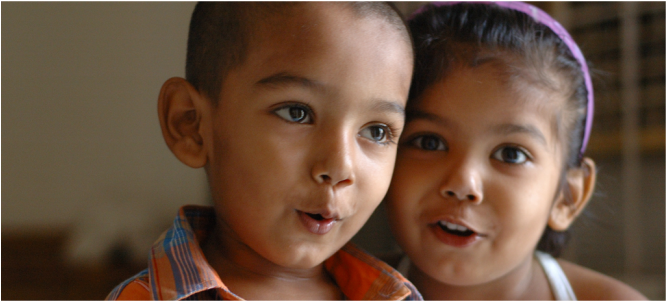|
Updated November 2023
Parenting is more than comforting children when they fall down, or making sure they get proper nutrition, and brush their teeth, and so on. Parents are responsible for their children’s spiritual training as well. You can constantly point a child towards the Lord, even from the time he or she is born, by talking to them about Jesus. You can pass a knowledge of the Bible on to them by daily using Bible story books and other devotional materials appropriate for their age. Following are some links to free online devotionals for toddlers, preschoolers and young children. These short, illustrated books, booklets and presentations will grab your little one’s attention and make him want to learn more about Jesus. Click on the links to either read these devotionals online or download them to your computer. Free Devotional Books: Big Thoughts for Little Minds – This series of five books brings key Bible passages to life in a relatable way for young children. The books include simple text, colorful illustrations and points for discussion to help little kids better understand Biblical principles. Click the following links to read or download the books for free: Jesus and Me – A series of books with messages from Jesus for children on themes such as: waking up, bedtime, kindness, healthy habits, learning new things, guardian angels, and protection. Click the following links to read or download these books for free: Seasonal Devotional Books – The following daily devotional books have been created for specific seasons:
Free Devotional Series: NEW! Thank God for the Seasons - Four short books with praises to God for the blessings of each season: In the Garden – A series of comics featuring a gardener and the children he works with. Children reading the booklets will learn valuable lessons about God’s love and care, kindness and consideration, obedience and the importance of spending time with Jesus each day. Coloring pages accompany the stories for added fun. Pray a Way – Colorful posters (with accompanying black and white pages to color) featuring rhyming prayers for just about every activity. A bible verse is included for each prayer. Topics covered include schooltime, mealtime, bedtime, holidays, grandparents and even pets. Bright Pebbles – Bright Pebbles is a collection of Christian and character-building books written for children ages four on up. Each devotional is built on a Bible verse, and explains to a child in simple terms what the principles of that verse mean and how it applies to daily living. The Bright Pebbles series is created by My Wonder Studio and there are currently over 85 of these devotionals posted online in pdf format for easy downloading. Additionally, a compilation of several books from this series can be downloaded for free in epub and mobi format. My Little Talks with Jesus – An ongoing series of short, devotional articles where Jesus talks with little children about day to day issues such as happiness, trying new things, forgiveness, going to sleep at night and more. This series is created by My Wonder Studio and all articles are in .pdf format for easy downloading. You can also download the ebook for free in epub or Kindle format. One Kind Deed at a Time – A series of ten devotional articles on the topic of kindness, consideration and forgiveness. Each devotional includes a Bible verse and practical ideas to put the article into action. This series is created by My Wonder Studio and all articles are in .pdf format for easy downloading. Through Every Day - Covers topics such as God's love, prayer, and kindness. A free coloring page accompanies every devotional. Basic Christian Principles for Little Children - Short devotionals to help children learn the basics of the Christian faith:
Other Free Devotionals for Little Kids
Devotionals from the Freekidstories Website - Freekidstories offers a range of free children’s devotional resources for babies, toddlers and preschoolers, including presentations of songs, illustrated simplified Bible verses and short devotional articles. Songs:
My Wonder Studio - The My Wonder Studio website is dedicated to creating free children’s stories, devotionals and activities that can be read online or downloaded at no charge. You can find materials for children ages 0-5 years here or check out stories and devotionals listed by category. Nurture, Inspire, Teach: Nurture, Inspire, Teach is a website dedicated to providing great online resources for children, teenagers and parents. Following are links to the site’s children’s devotionals for little ones.
To help your little one learn even more of God's Word, check out this list of free Bible stories online that your little ones are sure to enjoy. Some of these are available as PowerPoints while others are in .pdf and/or ebook format.
11 Comments
Families that share that common connection with God, whom the Bible calls love itself (1 John 4:8), are closer, more loving, more unified, and have far fewer serious problems among themselves than families that don’t. Why?—Because they have the most important things in common, besides a clear standard of right and wrong—the spiritual guidance and support they need to make the right decisions and stick to them. Click on the links for free illustrated and simplified Bible stories for children. Stories can either be read online or downloaded in .ppt or .pdf format. Bible Story Flashcards All flashcards can be downloaded for free (in .pdf format):
Bible Story Flannelgraphs These free Bible flannelgraphs cover stories from the life of Jesus, including the First Christmas, the healing of Jairus’ daughter, healing of the ten lepers, the parable of the lost sheep, the story of Zacchaeus and the story of the first Easter. All flannelgraphs can be downloaded in color or black and white. (.pdf format) Bible Story Presentations (PowerPoint) The following two sections contain Bible stories in PowerPoint presentation format; just right click an image and then select “save file as” or “save as” to download any Bible story onto your computer. Basic Old Testament Stories – Simple, colorful and nicely illustrated Old Testament stories for children. The stories found here include Creation, Noah and the Ark, Joseph, Moses, David and Goliath and Jonah. Basic New Testament Stories – New Testament stories found at this link include Jesus Calls 12 Disciples, The Good Samaritan, Jesus feeds 5,000, Jesus calms a storm, Jesus Heals a Blind Beggar, Lazarus lives again, The 10 Lepers, The Lost Sheep and The Prodigal Son. NEW! Old Testament Stories: (all stories can be read online or downloaded as a .pdf for free)
Life of Jesus (all stories can be read online or downloaded as a .pdf for free)
NEW! Parables of Jesus (all stories can be read online or downloaded as a .pdf for free) NEW! Stories of the Acts of the Apostles (all stories can be read online or downloaded as a .pdf for free)
Bible Story Books Some of these Bible story books can only be read online while others can be downloaded in .pdf, .epub or .mobi format.
Bible Passages and Prayers
Unless otherwise noted, all stories, flashcards, and coloring pages can be downloaded in .pdf format. Feel free to use them at home, church, or in other settings. Merry Christmas!
Christmas Stories and Books
Christmas Videos:
Christmas Coloring Pages and Activities:
It was a child who began the first Christmas celebration, and it is children who keep it alive in their own special ways. Christ manifests His presence in each child who celebrates His birth. May He also touch your life and home this Christmas. By Becky Hayes I had been praying for my son, Denith, to develop a close and personal relationship with Jesus while he was young, capitalizing on how much faith and capacity to believe two-year-olds have. I prayed that he wouldn't only come to know Jesus as his Savior, but also as the close and personal Friend that Jesus desires to be to everyone. I wanted Denith to sense His Spirit and to hear His voice. One night something very special happened that encouraged me and made me determined to teach my son more about how to hear from Jesus on his own. Denith had received a teddy bear when he was a baby, affectionately named "Teddy," and he was very attached to his stuffed friend. Everywhere Denith went—to preschool, to lunch, or to the supermarket—Teddy came along. One day Teddy was misplaced and could not be found. For three days we searched the house. I pulled everything out from under the bed in case he had fallen behind the bed and gotten stuck. The third night that Teddy was lost, I was putting my nine-month-old, Leilani, and Denith to sleep. The lights were out, and the children were all tucked into bed and ready to pray for the night, when Denith asked, "Mommy, where's Teddy?" "Honey," I said, "Teddy's lost. We need to look for Teddy during the day when there's light. Right now it's dark and we can't see. But why don't we ask Jesus to give Teddy a good night, and to help him be warm and cozy and sleep well." "Mommy, where's Jesus?" asked Denith. "Jesus is in your heart," I replied. "He's also in my heart, and He's all around us. If you talk to Him, He can hear you speak, and if you listen, you can hear Him talk to you." Without any further questions Denith promptly asked aloud, "Jesus, where's Teddy?" A short pause followed, and then in an excited but matter-of-fact manner, Denith exclaimed, "Oh, Mommy, Teddy is in the crib!" My body tingled with excitement. I knew that my son had heard Jesus answer his question. I didn't hesitate for a second. I began removing the toys and stuffed animals from the baby's crib. Sure enough, under the other toys, I saw Teddy. I was so touched by Jesus' love for Denith in rewarding his faith by answering him so clearly. It was also a good opportunity for me to show Denith that Jesus always has the answers. Courtesy of Activated! magazine. Used with permission. Photo adapted from Wikimedia Commons.
Adapted excerpts from Parents Magazine Many parents think that it’s premature to teach values to a toddler or preschooler. But that’s a misconception. Here are five values that all children should develop by their fifth birthday, and some easy ways to make them stick. Value #1: Honesty Help kids find a way to tell the truth The best way to encourage truthfulness is to be truthful yourself. Consider this story: Carol decided to limit the number of play dates between her 3-year-old son, Chris, and his friend Paul. The boys had been fighting a lot recently, and Carol thought they should spend some time apart. So when Paul’s mother called one afternoon to arrange a get-together, Carol told her that Chris was sick. Overhearing this, her son asked, “Am I sick, Mommy? What’s wrong with me?” Carol, taken aback by her son’s frightened look, told him she had only said he was sick because she didn’t want to hurt Paul’s mother’s feelings. Carol then launched into a complicated explanation of the distinctions between the various types of lies, and Chris was confused. All he understood was that fibbing is sometimes okay—and that, in fact, it’s what people do. Your child takes his cues from you, so it’s important that you try to avoid any kind of deception, even a seemingly innocent one. Carol would have been better off saying, “This isn’t a good day for a play date. I’m concerned that the boys were fighting so much last week. I think they need a break.” Even if being honest isn’t always easy or comfortable, you—and other people—will always feel better if you tell the truth. Value #2: Justice Insist that children make amends At a recent family gathering, Amy and Marcus, 4-year-old cousins, were making castles out of wooden blocks. Suddenly, Amy knocked over Marcus’s castle, and he started to cry. Witnessing the scene, Amy’s father chided his daughter and ordered her to apologize. Amy dutifully said, “I’m sorry.” Then her dad took her aside and asked, “Do you know why you pushed over his blocks?” She told him that she was mad because Marcus’s castle was bigger than hers. The dad told her that though this was no excuse for destroying her cousin’s castle, he could understand her feelings. He then sent her back to play. The father’s reaction was similar to that of many psychologically savvy parents: He wanted his daughter to identify and express her feelings and to understand why she behaved as she did. That’s okay, but it isn’t enough. Saying “I’m sorry” is pretty easy for a child, and it lets her off the hook without forcing her to think. Having a child make amends in a proactive way conveys a much stronger message. If you’re aware that your child has acted badly toward someone, help him think of a way to compensate. Maybe he can give one of his trucks to a playmate whose toy he has damaged. Perhaps he could draw a picture for his sister after teasing her all day. In Amy’s case, she could have been encouraged to help Marcus rebuild his castle. By encouraging your child to make such gestures, you emphasize the importance of treating people fairly—an essential value that will one day help her negotiate the complicated world of peer-group relationships. Value #3: Consideration Teach them to think about others’ feelings Anne was frustrated because her daughters, ages 3 and 4, ended up whining and fighting every time she took them grocery shopping. “I finally told them that we needed to figure out how to do our shopping without everyone, including me, feeling upset,” Anne says. The mom asked the girls for suggestions on how to make the trip to the grocery store a better experience for all. The 4-year-old suggested that they bring snacks from home so they wouldn’t nag for cookies. The 3-year-old said she would sing quietly to herself so she would feel happy. The girls remembered their promises, and the next trip to the supermarket went much more smoothly. Leaving the store, the younger girl asked, “Do you feel really upset now, Mommy?” The mother assured her that she felt just fine and remarked how nice it was that nobody got into an argument. Do these small problem-solving exercises actually help a child learn the value of consideration? You bet. Over time, even a young child sees that words or actions can make another person smile or feel better, and that when she’s kind to someone else, that person is nice to her. This feedback encourages other genuine acts of consideration. Value #4: Determination Encourage them to take on a challenge Determination is a value that you can encourage from a very young age. A powerful way to help kids develop determination is to encourage them to do things that don’t come easily—and to praise them for their initiative. If your son is shy, for instance, quietly encourage him to approach kids on the playground, even if it makes him feel nervous and scared. If your daughter gets angry quickly, teach her strategies (such as counting to ten or taking a deep breath) for holding back a temper tantrum. Congratulate kids when they manage to do things that are difficult for them. The child who hears “Good for you, I know that was really tough!” is bolstered by the recognition and becomes even more determined to keep trying. Value #5: Love Be generous with your affection Parents tend to think that children are naturally loving and generous with their affection. This is true, but for loving sentiments to last, they need to be reciprocated. It’s chilling to realize that over the course of a typical busy day, the phrase “I love you” is probably the one that a child is least likely to hear. Let your child see you demonstrate your love and affection for the people in your life. Kiss and hug your spouse when the kids are around. Talk to your children about how much you love and appreciate their grandparents, aunts, uncles, and cousins. And, of course, don’t let a day pass without expressing your affection for your child himself. Show your love in unexpected ways: Pack a note in his lunch box. Tape a heart to the bathroom mirror so he’ll see it when he brushes his teeth. Give her a hug—for no reason. Don’t allow frantic morning drop-offs or hectic afternoon routines squeeze loving gestures out of your day. I can practically guarantee you that the more you say “I love you” to your child, the more your child will say “I love you” back. The more hugs and kisses you give, the more your home will be filled with love and affection.—And when our children feel free to express their love to us, we instill in them perhaps the greatest value of all. Courtesy of Motivated! magazine. Used with permission. Photo by Yogesh Kumar Jaiswal via Flickr.
 Fred Genesse Concern: Learning two languages in childhood is difficult and can result in delays in language development. Response: Children who have regular and rich exposure to both languages on a daily or weekly basis from parents and other caregivers exhibit the same milestones in language development and at roughly the same ages as monolingual children. It is important to remember that there are large individual differences in children learning to speak—some acquire their first words or use complex utterances much earlier than other children. Delay in the emergence of these milestones does not necessarily mean that there is something wrong; in most cases it simply means that the child has taken longer to reach this stage. The same kinds of differences are characteristic of bilingual children. Concern: Bilingual children have less exposure to each of their languages than monolingual children. As a result, they never master either language fully and, compared to monolingual children, don’t become as proficient. Response: Bilingual children can acquire the same proficiency in all aspects of their two languages over time as monolingual children, even though they usually have less exposure to each language. They acquire the same proficiency in the phonological and grammatical aspects of their two languages as monolingual children do in their one language, provided they are given regular and substantial exposure to each. Bilingual children may have somewhat different patterns of development in certain aspects of language in the short term. Vocabulary is one of those areas. Sometimes, young bilingual children know fewer words in one or both of their languages in comparison with monolingual children of the same age. This is probably because bilingual children must store words from two languages, not just one. As well, because bilingual children learn words in each language from different people, they sometimes know certain words in one language but not in the other. When the vocabulary that bilingual children know in both languages is considered together, they generally know the same number of words and have the same range of vocabulary as their monolingual peers. Most importantly, when and if differences like these occur, they are short term and disappear with time. Generally speaking, bilingual children’s overall proficiency in each language reflects the amount of time they spend in each. Thus, a child who has just returned from a visit to a grandparent where only one of the languages was used, may prefer to use only that language for awhile and, thus, may appear to have lost some proficiency in the other language. This is usually a short term, temporary shift in preference that is corrected once the child is exposed to the neglected language. It is important not to overreact to these temporary fluctuations in proficiency since they are usually temporary. Parents can best ensure that their children achieve full proficiency in both languages by providing rich experiences with each, and especially with the language that might otherwise not get strong support in the extended community. It is important in this regard that parents who do not speak the majority language of the community continue to use their native language, so that they expose their child to varied and rich ways of using language. Concern: Young bilingual children can’t keep their languages separate; they use both at the same time. Response: At some stage, most bilingual children use sounds and words from both languages in the same utterances or conversations, even though the people talking with them are using only one language. Some parents and early childhood educators are concerned when they hear this because they believe that it means that the child is confused and cannot separate the two languages. Research shows that this is not true. The main reason for children mixing their languages in these ways is because they lack sufficient vocabulary in one or both languages to express themselves entirely in each language. Thus, they borrow from the other language. This is an effective communication strategy in most families because parents and other adults who care for bilingual children usually understand both languages and may mix the languages themselves when talking with the child. Research has shown that the most proficient bilinguals mix their languages in the most sophisticated ways without violating the rules of either language. It is normal for children growing up in these communities to mix their languages extensively because they are simply learning the patterns of communication that are common in their community. Compiled from assorted sources
Promoting Good Food Habits H. Darlene Martin, nutrition specialist Children often take the attitudes and habits they form during their preschool years into adulthood. So the preschool years are an excellent time to teach children that a proper diet is part of a healthy lifestyle. By 15 months old, most children can feed themselves without help—if they are allowed to try. It may be faster and less messy to feed a toddler, but helping him is not in the child’s best developmental interest. Give him the chance to feed himself. When preschoolers are allowed to choose from a variety of nutritious foods, they will take in adequate nutrients over time. Children need protein in order to grow. Milk, fish, poultry, eggs, cheese, and dry beans and peas all supply protein. Children also need calcium for strong bones and teeth. Calcium is found primarily in milk and milk products, but it is also found to a lesser extent in green, leafy vegetables. Iron is an important mineral. It is supplied by such foods as meat, poultry, fish, and eggs; green, leafy vegetables; and whole-grain cereals. (If you serve iron-fortified boxed cereals, the iron is absorbed better when served with a food rich in vitamin C, like citrus fruits and their juices.) Dark green or yellow vegetables are also good sources of vitamin C and vitamin A. Small children need plenty of water for regulating their body functions. A higher percentage of children’s body weight is water, so offer water to your preschoolers several times during the day. Children also need a certain amount of fat in their diet. Fat helps to provide extra calories and needed nutrients for active and growing children. Don’t restrict fat intake for children under the age of two. For children over two years old, fat should represent about 30 percent of total caloric intake. Sugary foods provide few nutrients and should be eaten on a limited basis. If left on the teeth, chewy, sticky, sugary foods (even those using natural sweeteners) may promote tooth decay. Give children the opportunity to brush after they eat, and teach them to brush properly to help diminish tooth decay. Most preschoolers experience food jags. For a time, they may eat only a few self-selected foods. Finicky food habits are often temporary. They usually disappear if you don’t make unnecessary rules about eating or make food choices an emotional issue. Don’t make food the object of bribes or punishments. If a child rejects a food, don’t make a big issue of it. Your insistence may make the child more determined to refuse the food being offered. Offer the rejected food at a different time. Preschoolers, like adults, should be allowed to dislike certain foods. If you really want to promote good food habits, set an example for the children in your care. Children learn by example, so take time to sit down and eat with them. If they see you enjoying nutritious foods, they will be more likely to give them a try. Feeding Dos and Don’ts Jan Faull Here are some suggestions to help improve your child’s eating behavior:
Whatever you do, don’t engage in a power struggle. Remember that your child alone controls what she swallows. You control the food you put on the table, so you can gradually influence your child toward good eating habits. But if you engage in an emotional battle of wills over eating, you’ll lose-and the negative repercussions could last for years. Coping with a Picky Eater—Not So Great Expectations William G. Wilkoff 1. After their first year, children’s growth slows down considerably. An infant’s growth in the first year is explosive. At one year he will have nearly tripled his weight and grown almost a foot long. By his second birthday, he is growing only about one-tenth as rapidly as in his first year. As a new parent, you may come to expect this phenomenal growth rate to continue into the preschool period. It will not happen. (If it did, your child would have a serious medical problem!) 2. After the first year, your child needs relatively fewer calories. As your child gets older, her body becomes leaner; in simple terms she loses her “baby fat.” Her new body proportions require relatively less energy to function. For the preschool child this means that she needs only half as many calories per pound of body weight than she did as a baby. This is why the two- to five-year-old may appear to be eating less as she gets older. 3. Children “streak eat.” Young children develop an affection for certain foods that may remain favorites for weeks or months or years, and then inexplicably fall out of favor without warning. Children may eat very well for a few days and then just pick for a week. It is the unusual child who will eat a wide variety of foods in consistent quantities day in and day out. 4. Babies are born with a natural preference for sweet and a dislike for sour. All other preferences or tastes for things are learned. Breast milk is intended to be your child’s first food, and it is very sweet. By repeated exposure you can modify your child’s preferences for most foods. However, she may always prefer sweet things when given a choice. 5. Children are wary of new foods. Although toddlers are prone to pick up and put strange things into their mouths that they shouldn’t, they are resistant to trying new foods. It just isn’t in their nature. This does not mean that you shouldn’t offer them new things to try, but your expectations should be low. For a hard-core picky eater, I wouldn’t suggest offering something new more than once or twice a week; you’re not trying to look for trouble, just trying to make a point. Once you get mealtimes to be more pleasant for all concerned, you can become more adventuresome. Until then, help your child by allowing her to have more success at eating by avoiding too many strange things in too short a period of time. 6. Young children’s appetites seem to decline as the day goes on. This is very important for a parent to understand. Exactly why children eat less later in the day is unclear. It may simply be that they have already consumed the necessary calories and their appetite shuts down, or it may be that they are more tired than hungry. 7. Not everyone loves to eat. You may already know this but may have trouble applying it to your own child. Just as there is a wide variety of body shapes and sizes, there is a wide spectrum of appetites across the population of children (and adults). Some people love to eat and move it near the top of their priority list for the day. Others only eat to stay alive and seem to get little pleasure out of the process. Fortunately, most of us enjoy eating but keep it in perspective when it comes to the rest of our lives. There are children who were picky for the first six years of their life and then as if by magic suddenly become voracious eaters. Other children remain indifferent to eating for their entire lives. Healthy Snacks for Toddlers Canada‘s Food Guide to Healthy Eating and Toddlers Toddlers have high energy and nutrient needs relative to their small body size. Their small stomach capacity has no room for foods that do not offer a good source of nutrients and energy. Offering a variety of nutritious foods at meals and snacks ensures a healthy diet. During this time, toddlers also experience fluctuating appetites, which cause great concern for parents. Children will generally eat when they are hungry. Parents may think their child is not eating enough. Remember that toddlers eat smaller amounts than adults because of their smaller stomach size. This is why it is important to offer healthy snacks between meals. Often parents forget to count snacks when they consider how much their child is eating during the day. Planning nutritious snacks is as important as planning meals. They should contribute to the child’s overall daily nutrient intake and provide energy. Snacks need to be offered well in advance of the next meal so they do not spoil the child’s appetite. To promote both dental and nutritional health, snacks need to be low in sugar and nutrient dense. Nutritionally and dentally healthy snacks are: Grain products: whole wheat breads, crackers, rolls, toast, muffins and loaves made with limited amounts of sugar, unsweetened whole grain cereals, rice pudding Vegetables and fruit: lightly cooked vegetable and fruit pieces, grated raw vegetables or hard fruit, unsweetened frozen or canned vegetables and fruit, vegetable and fruit juices Milk products: plain whole milk, yogurt, cheese, milk puddings and yogurt or cottage cheese dips Meat and alternatives: hard-boiled egg, pieces of lean meat or poultry, tuna, salmon, peanut butter or other nut spreads, hummus or other spreads made from pureed legumes (dried beans, peas, lentils) Do you want to channel your child’s unbounded energy and curiosity into positive and rewarding learning experiences? Keys to Toddlers and Preschoolers is a parenting guide with scores of fun, practical learning activities and suggestions to keep your ever on-the-go little one occupied for hours. More importantly, learn how to prepare
your child for life’s challenges and changes, and lay a foundation of faith that will guide and support him or her all through life. Treasure Attic is an exciting video series for children from 2 to 8 years of age. Full of fun and adventure, this series teaches children universal moral principles and values through story and song. Each half hour episode of Treasure Attic features its fun and personable host, Uncle Jim, his loveable sheepdog, Peepers, the energetic, word-defining Bunny Big Bigword and many other friendly animal puppets! Treasure Attic focuses on skills children need most:
Another plus is that each DVD includes three languages (English, Spanish and Portuguese), making these videos a good teaching tools for children who are learning a second language. Treasure Attic is recommended by the DOVE foundation as being a family friendly video series. These videos have been seen on stations around the world, have sold over 500,000 copies to date and have a dedicated following of happy viewers. You can view portions of these videos here or buy the DVDs online by clicking here. This free Treasure Attic guide and songbook is designed to help parents and teachers use these videos to their fullest potential. The guide can be read online or downloaded by clicking the download PDF icon. (Right click the file icon and then selecting “save as…” or “save file as”…
William J. Bennett, book excerpt Getting your child’s education off to a good start does not take extraordinary efforts or extravagant stimulation. You do not need a degree in child psychology. Raising a child does not require “trained caregivers” to supply expertise that parents lack. On the contrary, you are the most qualified person to teach and guide your young child, because he is a part of you and loves you. You should supply five basic ingredients in these years before school: your love, protection, and care; your time; a positive learning environment; an attitude that values learning; and strong moral training. Your Love, Protection, and Care All children come into the world fragile and helpless. In order to survive even a few hours, they need adults to supply food, shelter, warmth, and care. But meeting their physical needs is just the start. To develop well, from the very beginning children need a family. A deep commitment from at least one responsible, caring adult is crucial. (Obviously, having both a mother and a father in the home is the best arrangement.) Every child needs someone who gives uncompromising love and boundless devotion, someone whom that child can learn to love back. This is a basic fact of human growth and emotional development. Nothing is more crucial than giving your young child the feeling of being loved and cared for, and instilling a basic sense of trust that he can depend on you for nurture and protection. The emotional bond between parent and child has powerful effects on education. Preschoolers who feel loved are more likely to be confident, and confidence makes exploring a new world much easier. A strong, loving relationship increases youngsters’ eagerness to learn new things. For example, a child wants to learn how to read in part because he wants to please his parents, whom he sees reading and who encourage his own efforts to read. Children like to learn because they love their parents, and know their parents love them back! Forming a close bond with children is a natural part of the parenting process. Most moms and dads need no urging and little guidance here; these manifestations of love spring from the heart. The kinds of actions and gestures you instinctively want to offer your child are exactly the kinds he needs to gain a sense of nurture and protection. Holding and cuddling him from the day he is born, talking to him, playing with him, setting rules that are good for him, telling him over and over again that you love him—such actions and expressions have a profound impact on his development now, and on the kind of student he’ll be later. Children thrive when they have parents who are loving and dependable, when they know that, no matter what may happen in their lives, someone will look after them, keep them safe, and show them the limits of good behavior. When it comes to young children, loving and learning go hand in hand. Your Time The best way to show your love and help your child learn is to spend time with him. Shaping good attitudes and habits takes time. Setting good examples takes time. The encouragement your youngster craves—whether it’s for learning how to climb the stairs, how to read his first word, or how to write his name—requires your time and presence. You have to be available, perhaps more than you imagined. It has become popular in recent years to distinguish between “quality time” and “quantity time.” Some parents want to believe that they can spend fewer hours with their children so long as they put that shared time to good use. The fact is that children do not flourish on small, concentrated doses of attention from mothers and fathers. They need your frequent company if they are to learn from you. This may be a hard truth to accept in these modern days, but it is reality. For children, quality time is quantity time. When it comes to teaching and learning, there is no substitute for lots of time together—and children know it. In the eyes of your child, your presence in his life is proof that you are interested and that you care. It shows that he comes first—not your work, or your friends, or a ball game on TV. In his book The Hurried Child, Professor David Elkind tells this anecdote about a conversation he overheard when visiting his son’s nursery school class: Child A: “My daddy is a doctor and he makes a lot of money and we have a swimming pool.” Child B: “My daddy is a lawyer and he flies to Washington and talks to the President.” Child C: “My daddy owns a company and we have our own airplane.” My son (with aplomb, of course): “My daddy is here!” with a proud look in my direction. Keep in mind that one reason the preschool years are unique is that, in all likelihood, this is the period when your child wants your company more than he wants anyone else’s. He’s interested in what you have to say (most of the time, anyway). You’re his best pal. Later, he’ll often be elsewhere: in class, with his friends, or in his room, away from mom and dad. The preschool years offer the most opportunities to be together. Don’t neglect them. Chore Time Is Teaching Time If you’re like most parents, much time with your child is also chore time. Sure, you’d like nothing more than to spend most of the day reading aloud, taking trips to the zoo, and playing “educational” games that will help him grow. Unfortunately, you’ve also got to get an oil change, rake the backyard, take out the trash, and clean the spare bedroom before Uncle George comes to visit. The good news is that those pesky chores also have teaching value. With a little effort, you can turn many household routines into good learning opportunities for your child. He learns an enormous amount in your company if you simply talk to him as you work. Never mind feeling slightly foolish. Explain what you are doing. Tell him why you are doing it. He’ll pick up all sorts of vocabulary and absorb knowledge about what things are and how they work. Almost any household activity can become an informal lesson. Writing a grocery list can be a perfect chance to practice recognizing some letters. (“I’m writing the word butter. Do you remember what that first letter is?”) Cooking invariably involves weighing, measuring, counting, and grouping. (“I have to fill this cup until it is half full. Will you tell me when the milk gets to this line right here?”) Doing the laundry can be a sorting game. (“Why don’t you help me put all the socks in this pile, and the shirts in that pile?”) Sprinkle your routines with questions. Running errands in the car: “Who can count the green cars on the road? In the study: “How many books do I have on my desk?” Daily routines draw on a whole range of organizational and problem solving skills, the same skills your child will someday need to complete a school assignment or project at work. He can learn the value of planning ahead, and then executing the plan. He gradually comprehends that every large job is really a series of smaller tasks. He sees that work is a means to an end. When he helps, he learns about teamwork. Certain character lessons will seep in too. By watching you, he learns about sticking with a task until it’s finished. He sees how to perform a duty thoroughly and responsibly. If given the chance to make even small contributions, he begins to learn the satisfaction of a job well done. Above all, keep talking. The stimulation, the exchange of ideas, and the responses elicited will all serve to build up a host of skills, making chore time a teaching time, and making it more enjoyable for both of you. A Positive Learning Environment One of your fundamental jobs is to give your child some experiences that pique his curiosity and supply fundamental knowledge about the world. This does not mean bombarding him with glitzy, noisy stimuli all day long, going out and buying lots of fancy “educational” gear, or enrolling him in the most expensive preschool in town. It mostly entails making sure he has interesting things to do. Since the world is so novel to him, and he naturally wants to explore it, this is not a difficult task. In fact, for children this age, a “learning environment” often consists of everyday activities—playing with toys, watching a parent do chores, or running around the backyard. Expose your child to a widening range of experiences as he grows. A baby who has just learned to crawl is a little Marco Polo, anxious to explore all those mysterious corners of your living room and kitchen. Give him the freedom to investigate while you are nearby. (Make sure you’ve taken precautions to childproof your home!) As he grows, give him changes of scenery. Take him with you on errands to the bank or hardware store. Take a trip across the street to meet your neighbor’s new puppy. Find a hill for your toddler to run up and down. Just about any place you go, there will be something to stimulate his curiosity. As he grows through the preschool years, organize little “field trips” to check out less familiar bits of the world. Spend an afternoon at the science museum. Take him to the airport to see planes land and take off. Or into the country to get a pumpkin. Lie on your backs to watch the clouds on a summer afternoon. And, of course, read all sorts of books to him. Introduce your child to different people: extended family members, neighbors, and figures in the community. Point out the police officer, the fireman, the postman. Youngsters who know only their immediate family are less likely to thrive in the larger world and may be either too trusting or too nervous of others. Choosing Toys That Teach Toys are the “tools” of learning for kids in the pre-kindergarten years. Keep in mind, though, that rarely does the teaching value of a toy have a direct relation to how many batteries it uses or lights it flashes. A high price tag does not make it better for your child. Expensive toys that claim to teach tykes are often less “educational” than some pots and a big wooden spoon from the kitchen. Computer software is often little better for kids than sitting and watching TV. It certainly isn’t as helpful as spending time with a parent reading, counting, playing games, or taking a walk in the park. Often it’s the simple toys that do the best job putting little imaginations and muscles to work. For toddlers, the old standbys you played with in your childhood are still fine: balls, blocks, cups, pans, plastic rings, simple puzzles, a sand box. A well-stocked box of construction paper, crayons, washable markers, glue, buttons, felt, and safety scissors is a treasure chest for preschoolers. A big basket filled with grown-up clothes and costumes (dime store crowns, plastic armor, discarded necklaces) is a big draw for most children. There is no need to keep adding toy after toy to the mix. Most parents eventually learn that the more toys they buy, the more toys they see sitting untouched in the back of the closet. Children who possess several chests full of playthings often flit from one to another without really appreciating any of them. Ironically, too many toys can lead to boredom—or worse, to a spoiled and ungrateful child who constantly thinks he’s entitled to another present. An Attitude That Values Learning How do you teach that you value learning? First, and perhaps most important, by your good example. Your actions always speak volumes to your child. Your own reading, wondering out loud, pointing things out, and showing a general interest in the world are powerful signs of your attitude about learning. You also instill ideals about education with your excitement over your child’s discoveries and achievements. Enthusiasm is contagious with preschoolers. If he sees you responding warmly to his attempts to learn, he’ll take pleasure in them, too. Ask questions about what he’s doing, and answer any questions he has. Take part in his activities by introducing him to a new book or game, or helping him with something that’s giving him trouble. Even just playing with your child will be interpreted as a sign that you care about what he’s learning. Keep in mind that it is difficult for anyone else to take a parent’s place when a young child looks for reinforcement about learning. Chances are, no one else (except perhaps grandpa and grandma) will get as excited as you when your child takes his first step, or speaks his first word, or counts to ten for the first time. No one else is going to be able to muster quite as much interest in that misshapen piece of clay he says is an elephant. The more you are there to encourage his efforts, the more he’ll want to learn. Adult responses can mean everything. Imagine three children, each frequently receiving a particular message: Scene 1: Little Girl: “Daddy! Look what I found!” Dad: “What have you got there? That’s a beautiful leaf. Where did you find it?” Little Girl: “In the yard.” Dad: “Where do you think it came from?” Little Girl: “That tree.” Dad: “I bet it did. What does it feel like?” Little Girl: “Like paper.” Scene 2: Little Girl: “Daddy! Look what I found!” Dad: “We need to go, honey. Leave that here.” Little Girl: “It’s a red leaf.” Dad: “I told you to put it down. It might have bugs on it. Now come on, we don’t have time for that.” Little girl (dropping the leaf): “Yuck. Leaves have bugs on them.” Scene 3: Little Girl: “Look what I found!” Baby-sitter: “That’s nice.” Little Girl: “It’s a leaf.” Baby-sitter: “I see that. Why don’t you go play with your toys?” Little Girl: “I want to show Daddy my leaf.” Baby-sitter: “Daddy won’t be home until after you’ve gone to bed. You know that. You can show him on the weekend, OK?” It’s not difficult, is it, to tell which child’s curiosity is being encouraged, and which ones’ inquisitiveness is being dampened? Early Moral Training A child who is already learning about traits such as responsibility, self- discipline, and perseverance before he begins school has a good shot at doing well at his studies. Conversely, if he shows up in class with bad habits such as laziness and disrespect for elders, there is little that teachers can do. An education disaster is already in the works. This is not to say that your preschooler must always be an angel. All children test boundaries and stray from model behavior. In the end, however, despite some who will tell you that peers or the popular culture have more influence than nurturing parents on how a child acts, the buck stops squarely with you. You are responsible for the way your young child behaves. You teach your child good character in several ways. You do it by your good example. Little eyes are watching. As you do, so will your child do. You teach virtue through high expectations and clear, consistent rules. You also form character in children by talking to them about good and bad behavior. There is much unwarranted cynicism and embarrassment today about “moralizing.” Little children need to be told about right and wrong, and when adults stand silent, then we shouldn’t be surprised if young people grow up with muddled notions of how to conduct themselves. Parents can talk about good character in the context of everyday actions, as well as in stories they read to children. They can talk about it in the context of their faith—which for most of us serves as the bedrock of morality. Teachers say that many moms and dads are falling down on the job of character training. They are not sending to school children who are well behaved, ready to work hard, and respectful of adults. Says a Texas teacher, “Some kids come to class with an attitude that they don’t have to listen to you, that just because you’re an adult, you don’t have the right to tell them what to do. They think they’re in charge, because they don’t have that structure at home.” Frequent among educators, these exceedingly sad commentaries explain much that is wrong with our schools. Reference: The Educated Child - A Parents Guide from Preschool through Eighth Grade. Free Press (1999)
|
Categories
All
Archives
March 2024
LinksFree Children's Stories |
||||||||









 RSS Feed
RSS Feed
